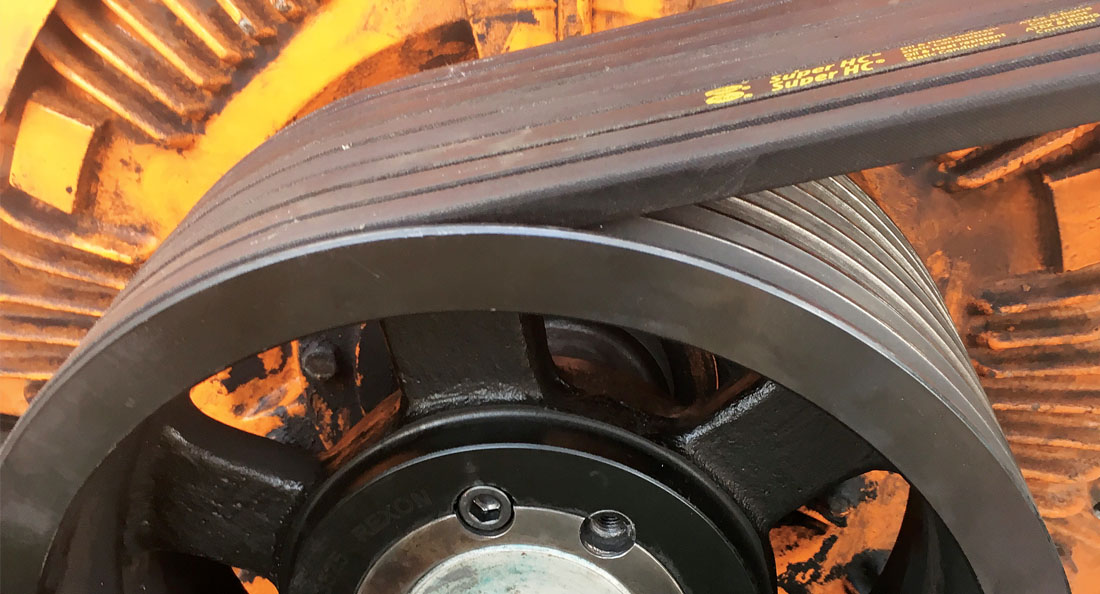When it comes to paper and cardboard recycling, Australia is relatively well-positioned globally. The National Waste Report 2018 shows that about 60 per cent of Australia’s paper and cardboard waste is recycled1, with other estimates putting the figure as high as 87 per cent 2.
All paper or cardboard recycling processes often begin by shredding the raw material in an industrial shredder – also known as a mulcher – before moving on to pulping, de-inking, drying and rolling of new paper.
Overloading or feeding wet cardboards into a mulcher can send shock loads to the machine, resulting in the drive not performing to its optimum capacity.
This was the case with an operator using a 250-horsepower mulcher – their existing v-belts tended to slip under the severe load conditions, which eventually caused the belts to fail prior to their required service lives.
The CBC engineering team, after studying the issue, recommended replacing the existing v-belts with new Gates Poly Chain® synchronous belts to allow the mulcher to operate at its desired capacity.
Since synchronous belts rely on tooth grip and not on slip (as is the case with v-belts), the drive system also needed to be replaced. The CBC team proposed using 56-tooth and 112-tooth driven sprockets to replace the existing drive system of the paper and cardboard mulcher.
Steve Hittmann, CBC Australia’s National Product Manager for Mechanical Drives, says the solution enabled the plant operators to run the mulcher to desired capacity, without requiring any maintenance in the 18 months that followed their installation.
“The Gates Poly Chain® GT™ Carbon™ belt gave the site the ability to operate the mulcher at their desired level of severe shock loads. The belts have been working without any slip under high load conditions, resulting in maintenance-free and higher capacity operations,” says Hittmann.
Poly Chain® is a polyurethane belt that replaces traditional roller chain applications for power transmission. It uses carbon fibre tensile cords to provide an increased power carrying capacity and extended flex fatigue life, helping it withstand shocks, surge loading and heavy abrasion.
In addition, Hittmann says the Gates Poly Chain® synchronous belts offer energy saving benefits when replacing v-belts, older synchronous belts and chain drives.
“Since v-belts have thicker cross sections than synchronous belts, they need more energy to bend around sheaves. Gates Poly Chain® synchronous belts offer up to 5% energy savings over v-belts,” he explains.
Synchronous belts are toothed and require the installation of mating grooved sprockets. These belts maintain their efficiency over a wide load range. In applications where v-belts lose their efficiency at high torque due to increased slippage, synchronous belts can offer a better solution.
“The Gates Poly Chain® synchronous belts require minimal maintenance and re-tensioning and run slip-free,” says Hittmann.
Poly Chain® GT™ Carbon™ belts operate on Poly Chain® GT™ sprockets and do not require any adaptation of existing GT applications.
Gates distributes its power transmission products through CBC and the two companies work closely to support the Australian market with their technical expertise. CBC operates more than 35 branches across Australia, with each branch employing experienced product managers and engineering support teams to provide everything from design, installation and fitment.
If recycling plant owners wish to re-design their plants to reduce downtime and increase their efficiency, they can contact the CBC support team, who will conduct a thorough survey to come up with the best solutions. They also offer training for maintenance staff if necessary, according to Hittmann.
“Gates and CBC have had a strong relationship going back to the early 90s and have both grown in that period,” he says.
“The combined expertise of CBC and Gates specialists ensures that customers get the best belts and drives solutions for their plants.”
References
- 1 – “Analysis of Australia’s municipal recycling infrastructure capacity” report published by the Department of the Environment and Energy, October 2018
- 2 – CEPI Sustainability Report, 2018
Advantages of Poly Chain® GT® Carbon™
• Maintenance free.
• 400% greater capacity than HTD belts.
• 5% energy savings over v-belts.
• 99% efficiency for life of the drive.
• Cut maintenance and downtime.
• Carbon cords easily handle shock loads.
• Reduce weight and overhung loads.
• Over 120,000 possible drive combinations.
• Inert to most acids, chemicals and water.
• No need for constant re-tensioning.
• Width for width roller chain conversions
• No stretch, no lubrication, no re-tensioning
• Outlasts roller chain up to 4 to 1
• Outlasts roller chain sprockets up to 10 to 1
• Inside and outside idlers can be used
A brief belt history
Over the years, The Gates Rubber Company has played a lead role in the development of engineered rubber products.
It all began in 1917 when John Gates invented the v-belt which revolutionised the methods of power transmission in industrial and automotive machinery. Then in 1946, Gates developed the first rubber synchronous belt to synchronise the needle and bobbin movement of the Singer sewing machine.
Since these two major events, Gates has introduced numerous innovative products, such as Predator® and Poly Chain®GT® Carbon™. With each new product, Gates has helped industry overcome problem belt applications and eliminate maintenance liabilities.
Today Gates, in partnership with its national distributors like CBC, can offer customers the leading range of industrial belt products including V-belts, V-ribbed belts, synchronous belts, tensioners, pulleys, sprockets and complete drive solutions.
In 1998 The Gates Rubber Company firmly established its commitment to the south pacific region with a new warehouse and service centre located in Dandenong, Australia. Supporting distributors with a wider range of inventory, providing power transmission training seminars and increasing technical service in the field, which better services customers of Gates.




